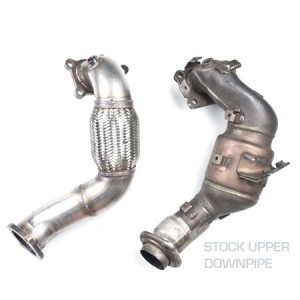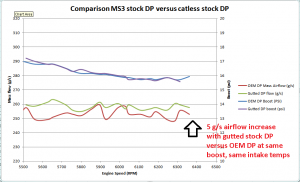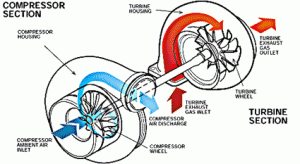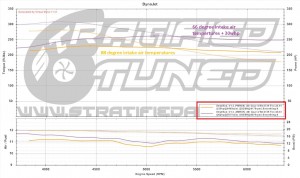We get lots of questions regarding what engine modifications to purchase and in what order for the Mazda 2.3l DISI Turbo (we will not discuss suspension and chassis improvements here). This article aims to provide a brief description of what we feel is the best bang for the buck mod path.
If you have questions regarding tuning in general or the MazdaSpeed platform we often update our Tech Blog and FAQ with useful information.
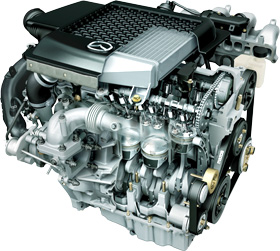
Rear motor mount – This adds a little extra vibration but if you drive your car hard this is a must since the stock one allows for too much engine movement.
Intake – There are lots of close to stock sized intakes out there from many manufacturers and they almost all work similarly. These ‘stock sized’ intakes usually will not throw a code and can be run on an otherwise stock vehicle. The best performance stock sized intakes are the cold air intakes. Common examples of ‘stock sized’ intakes are the JBR Power Path, CorkSport SRI, and COBB SF SRI. On the stock turbo you can also go for a 3″ intake and turbo inlet pipe. If you have a larger turbo then a 3 inch or larger intake is a must. For the MazdaSpeed K04 turbo a stock sized intake (2.63″) will work well. That being said, a larger intake always allows for a bit more flow and less restrictions (Going from a 2.63″ to 3″ intake can yield 10whp on the K04). You can read our technical discussion about intakes for more information. Please note that with a larger than stock sized intake you must get a tune such as our S-OTS+ Maps which are created to match your intake and modifications.
COBB AP + Stratified S-OTS+ – The COBB AP opens your ECU to the world of tuning. The AP is a modification which will grow with your build as you bolt on modifications all the way from the intake you just installed to the big turbo build you’ve always dreamed of. The best and most affordable way to get a feel of being ‘Stratified Tuned’ is the S-OTS+ map, you can read more about the S-OTS+ here: Stratified MazdaSpeed S-OTS+ Maps. If you have a JBR Power Path intake you can run the Stratified S-OTS maps which are available HERE. **Other intakes require a different MAF calibration which calls for an S-OTS+ Map**
High Pressure Fuel Pump – At this point you will need more fuel than the stock high pressure fuel pump can deliver. Fuel dips in the 1500psi and lower range at WOT indicate a need for a pump. Either get internals that you replace yourself or a full pump (which is quite a bit more expensive).
1 step colder plugs – Gap these plugs to 0.025-0.026″ and go with an NGK or Denso. Read our write up dedicated to spark plug tech for more information.
Race Pipe – A race pipe frees up the exhaust by removing the second 2-way catalytic converter. At this point you will be at the 250-275whp mark on a Stratified S-OTS+ tune.
Intercooler – Cooler air charge prevents knock so at this point consider upgrading the top mount intercooler to a larger top mount (such as ETS or CP-e) or to a front mount (FMIC). We recommend a FMIC since it will not become heatsoaked from sitting on top of the motor (the COBB FMIC bolts up to gen2 MazdaSpeed3 without removing the front crash bar). Furthermore, FMICs have access to more streamlined, cooler, air which helps to keep your BATs down. A larger TMIC may have marginally better throttle response due to less piping being involved, however, the engine bay is no place for an intercooler. The intercooler is both a knock reducer as well as a modification that increases overall flow of the system. Water injection is also a good alternative if executed well.
COBB AP + Custom Tune – A custom tune will make the biggest difference as far as power, driveability and reliability are concerned. With a custom tune you should be around 300whp on a healthy motor running good 93 octane gas. On a 25% E85 mix expect 320-340whp. At this point the stock K04 is the biggest restriction.
Increasing Octane – The MazdaSpeed DISI engine (as well as most others) see significant increases in performance from increasing timing up to the point of mean best torque (MBT). Using 91 and even 93 fuel (with some exceptions) does not allow us to optimize ignition timing (reach MBT) fully as we are limited by the knock threshold. In order to increase the knock threshold (‘raise the roof’) which allows us to run significantly more timing, the octane of the fuel must be increased. Different areas have access to different fuel qualities (and 93 octane is not the same everywhere believe it or not) so it is very important to choose the best octane available and use a well frequented gas station (we generally recommend top-tier stations such as Shell and Chevron). Further to this, octane can be increased significantly by blending some E85 (3-4 gallons for tank of premium) or, if E85 is not available, installing a water methanol injection (WMI) kit. These modifications can yield significantly more power (20-30whp on a stock turbo) and they do require a custom tune to realize the full benefits. Read our technical write-up on the benefits of E85 for a more in depth analysis of running ethanol blended fuels.
Aftermarket BPV – When going big turbo or whenever you are tuning above 20-21psi the OEM BPV should be upgraded as it will start to bleed pressure. This article outlines the effects of swapping the OEM BPV with an aftermarket BPV on a BNR S3 build.
At this point, with good fuel and all the modifications mentioned above, you will be in the 300-330 WHP range with the OEM K04 turbo and a Stratified Full Custom Tune.
Big Turbo + Downpipe + Larger Intake (3″ and above) + Custom Re-tune – Here you are swapping out the OEM K04 for a larger turbo and there are many to choose from. We recommend that you keep the frame size at a GT30 or smaller unless you plan on upgrading the fuel system. Depending on your choice of turbo, this where is you run will out of injector headroom – at around 400whp give or take a few ponies.
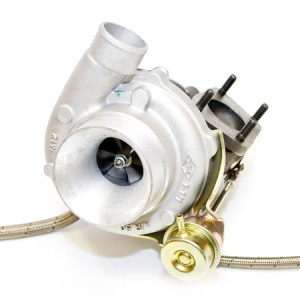 Before installing your turbo you will have to have the following supporting modifications in place, if you are purchasing a Stratified Big Turbo +Tune Package you will need all of these supporting modifications:
Before installing your turbo you will have to have the following supporting modifications in place, if you are purchasing a Stratified Big Turbo +Tune Package you will need all of these supporting modifications:
– A 3 or 3.5 Bar MAP sensor (The OEM MAP sensor only reads to 21-21.5psi )
– A 3″ or larger intake (OEM sized intakes generate a cut when getting above 330-340whp). We recommend something with a 3″ ID such as the JBR Tru-3.0.
– An aftermarket BPV (the OEM BPV starts leaking above 21psi)
– A 3 Port EBCV (This is needed to control boost on non-OEM turbochargers)
– Higher octane fuel (To get above ~350-360whp higher octane fuel than 93 is needed either through E85 or WMI mentioned above)
– An aftermarket 3″ downpipe with a single catalytic converter (either in the DP or in the testpipe) is recommended.
Turbo Choices: There are several turbos you can choose from for the MazdaSpeed DISI motor, here are some of the key players and their pro’s / con’s:
1. ATP/Garrett GT2871R: This turbo is good for up to 400WHP on the MazdaSpeed DISI motor and will offer response that is close to OEM with much better top end performance. This is a responsive turbo which will produce a very broad (flat) torque curve.
2. BNR S3: This turbo is very comparable to the Garrett GT2871R and really hits a sweet spot at around 350-370WHP. Response of this turbo will be slightly better than the GT2871 but worse than the GTX2867, the BNR S3 flows less than both the aforementioned Garrett turbochargers. This is the most affordable turbocharger on the list and, like the GT2871 and GTX2867, is capable of 400WHP with good fuel and a proper tune.
3. ATP/Garrett GTX2867R: Very similar to the GT2871 the Garrett GTX2867 turbos take advantage of Garrett’s latest turbo technologies. Featuring an 10-blade compressor wheel and ball bearing center cartridge these turbos provide quicker spool, lower BATs, higher boost, and more fun! Behaviour of the GTX turbo is similar to that of the GT turbo, however, the GTX turbos are more efficient across the board. The GTX2867 offers response that is better than the GT2871 while flowing around the same amount of air. Although ATP also sells GTX2860 and GTX2863 turbo kits, they are less commonly seen due to their decreased performance compared to the GTX2867.
4. ATP/Garrett GT3071R: This turbo is the next step up from the GT2871R, it is the best spooling turbo for surpasing the 400 WHP mark. When surpassing 400WHP it is recommended to build the block. Supporting mods for passing 400WHP include, depending on fuel quality, additional fueling (WMI, 5th or 6th port injection) E85 or WMI. Also, an upgraded intercooler is recommended due to increased flow and better cooling. Spool and response of this turbo will be slower than the OEM K04 turbo.
5. ATP/Garrett GT3076R: The ‘standard’ turbocharger for making up to 500WHP (see the bottom of this page). This turbo will spool a couple of hundred RPM later than the GT3071 and will produce more power right to redline. To extract the full potential of this turbo it is recommended that you have an upgraded intercooler (increased flow and better cooling), exhuast, as well as additional fueling (WMI and/or 5th/6th port injection). To prevent knock E85 or WMI is often needed to get above 350-375whp. At this point WMI really starts to shine as a properly setup system will provide cooling, increased octane, and increase the fueling headroom.
6. ATP/Garrett GTX3076R / GTX3071R: A step up from the GT3071R or GT3076R turbochargers the Garrett GTX30xx turbos take advantage of Garrett’s latest turbo technologies. Featuring an 11-blade compressor wheel and ball bearing center cartridge these turbos provide quicker spool, lower BATs, higher boost, and more fun! Behaviour of the GTX turbo is similar to that of the GT turbo, however, the GTX turbos are more efficient (more responsive) across the board.
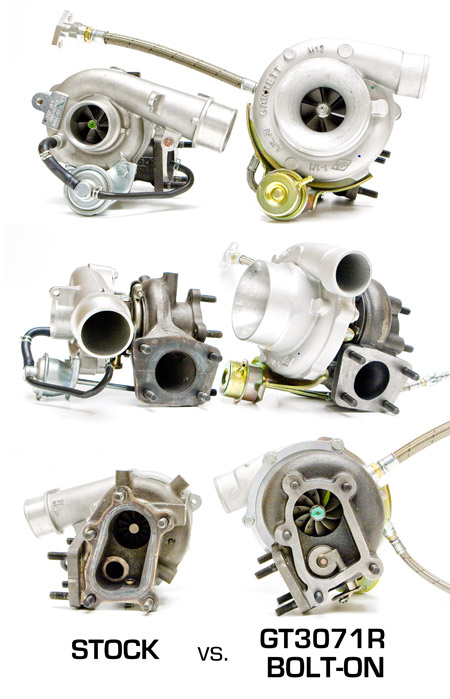
Remember that we sell the majority of turbos on this list packaged with a full custom tune, you can read more about this deal here: ATP Turbo + Stratified Custom Tune Package
Want to go further?
Bigger Intake (3.5″ or 4″), Exhaust Manifolds, More boost (GTX30xx), More fueling 400whp+– Exhaust manifolds are nice to have and give you a bit more flow and can be used earlier than this … remember that at this point you should be considering additional fueling to support the power you are making. Once you start going well beyond 400whp you will require additional fueling such as an auxiliary fueling system (WMI and/or 5th/6th port injection) and tuning tweaks. Also consider building the motor if you are consistently over 400 wheel torque and hp.
That’s all folks, please remember:
We can help with any of your tuning needs just fill out the Stratified Tuning and Modifications Adviser Form. Once you have submitted the form a platform specialist will analyze your responses and help guide you along the path to modifying your MazdaSpeed or MPS successfully and efficiently.
The Stratified Team


